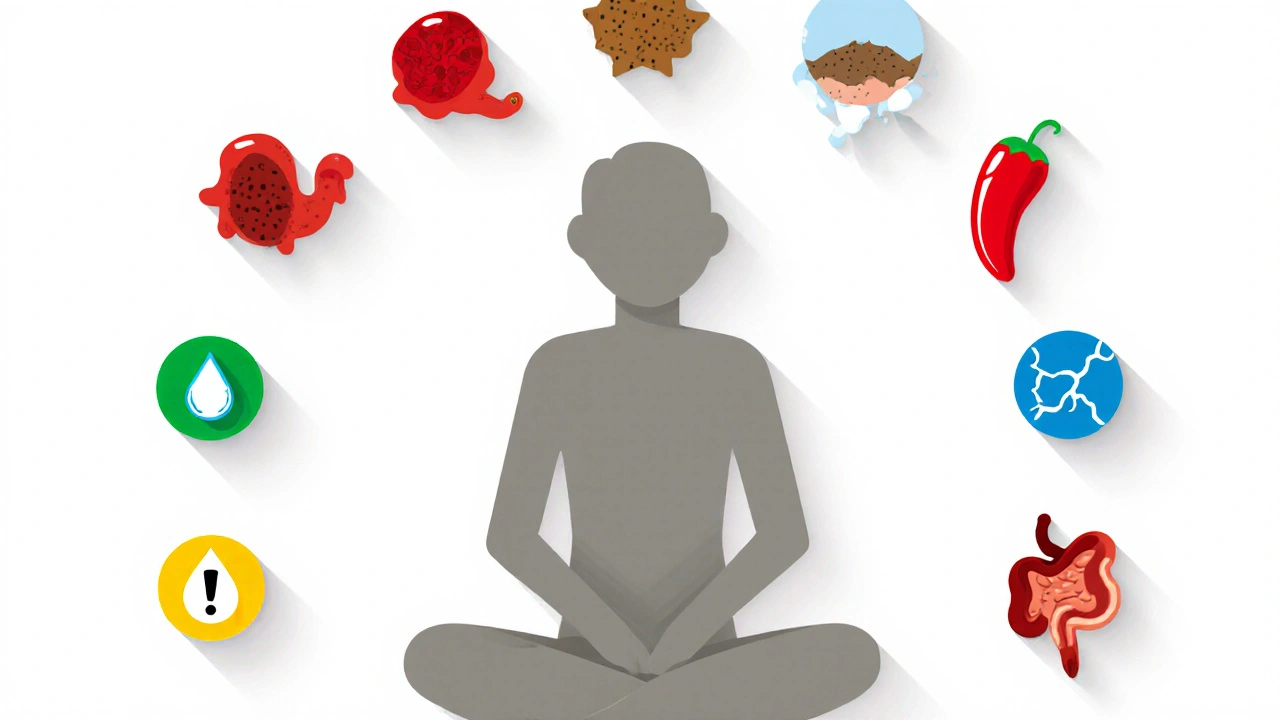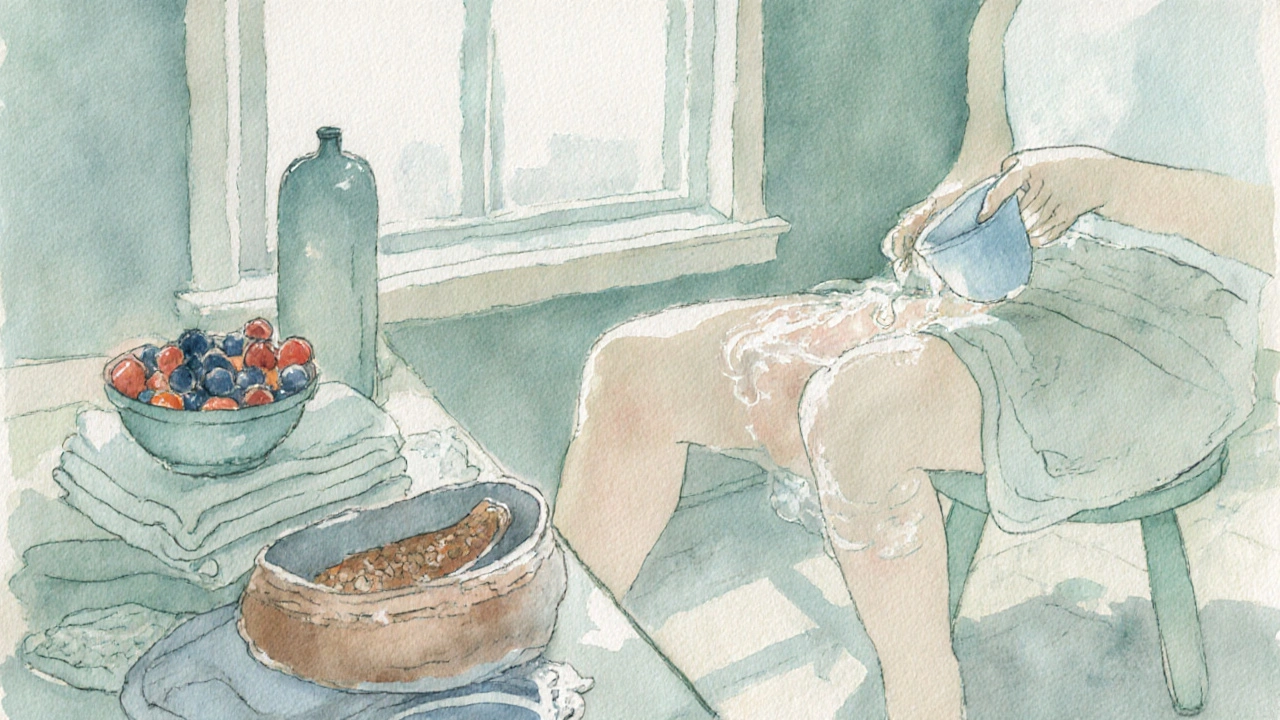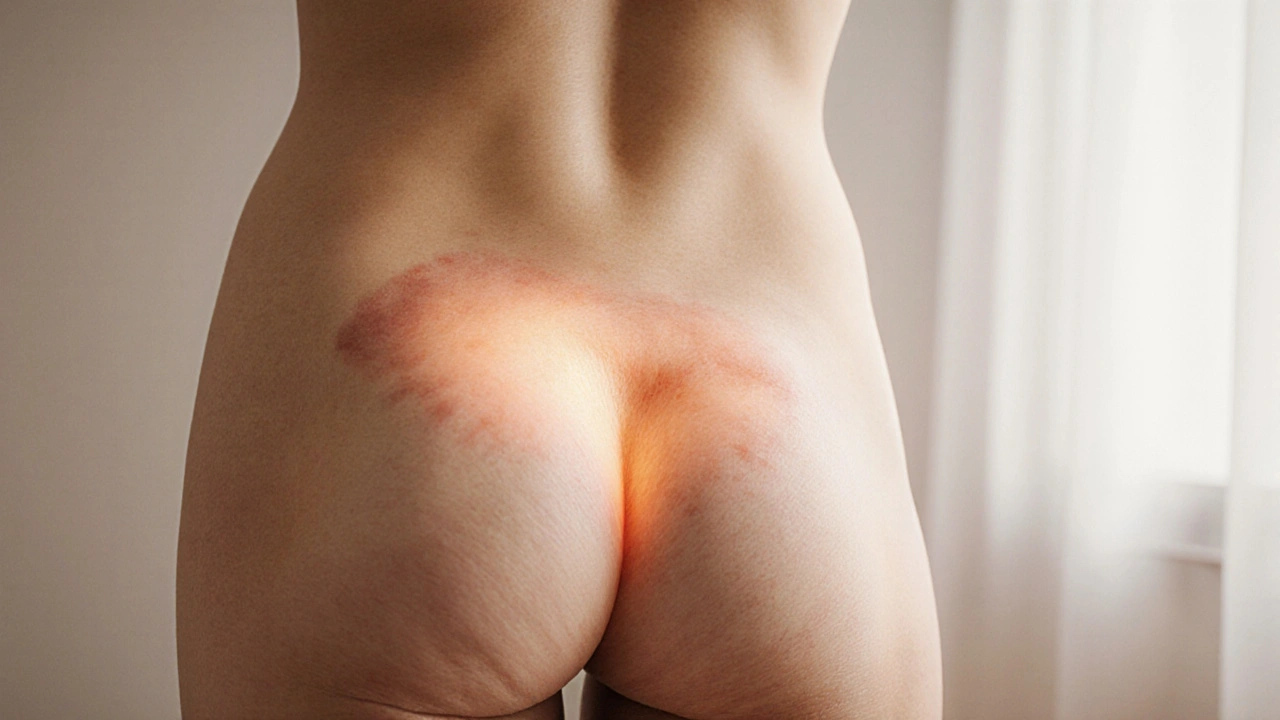Anal Itching Causes Explorer
Click on each cause below to learn more about its symptoms and treatment options.
Hemorrhoids
Itch, swelling, bleedingFungal Infections
Red rash, moisturePinworms
Nighttime itchingIrritant Soaps
Dry, burning itchSkin Conditions
Scaly, red patchesSexually Transmitted Infections
Sores, bumpsAnal Fissures
Sharp pain, lingering itchSystemic Conditions
Chronic diarrhea, bleedingMoisture/Sweat
Maceration, frictionFood Allergies
Histamine responseWhen you feel a relentless tickle around the rear, you’re experiencing anal itching, also known as pruritus ani. It is a common problem that can arise from simple irritants or from more serious medical issues. Understanding the root cause is the first step toward relief.
Quick Takeaways
- Hemorrhoids and anal fissures are the top two triggers.
- Pinworm infection is common in children and can cause night‑time itching.
- Moisture, harsh soaps, and food allergies often go unnoticed.
- Skin conditions like eczema and psoriasis can affect the anal area.
- See a doctor if itching persists for more than two weeks or is accompanied by bleeding.
What Is Anal Itching?
The sensation of itch around the anus can be mild or severe, constant or occasional. It may worsen after a bowel movement, during sweating, or when you sit for long periods. While occasional itch isn’t alarming, chronic pruritus can lead to skin damage, infection, and embarrassment.
1. Hemorrhoids
Hemorrhoids are swollen veins in the lower rectum or anus. They cause itching, burning, and sometimes bleeding when irritated by stool or wiping. External hemorrhoids are particularly itchy because the skin over them is thin and sensitive. Lifestyle tweaks-high‑fiber diet, plenty of water, and gentle cleansing-can shrink them, while over‑the‑counter creams provide temporary relief.
2. Fungal Infections (Candida)
Candida infection is a yeast overgrowth that thrives in warm, moist environments. When it colonises the anal folds, it produces a red, itchy rash that may ooze. Risk factors include diabetes, recent antibiotic courses, and tight clothing. Antifungal creams applied twice daily for a week usually clear the infection.
3. Pinworm (Enterobius vermicularis)
Pinworm infection is caused by the tiny nematode Enterobius vermicularis. The female lays eggs around the anus at night, leading to intense itching that awakens the sleeper. It’s most common in children but spreads easily in households. A single dose of mebendazole or pyrantel pamoate, repeated after two weeks, kills the worms; all family members should be treated.
4. Irritant Soaps and Hygiene Products
Harsh detergents, scented wipes, and antibacterial soaps can strip the delicate skin of its natural oils. The resulting dryness triggers a vicious itch‑scratch cycle. Look for fragrance‑free, pH‑balanced cleansers, and rinse thoroughly with warm water.
5. Moisture and Sweat
Staying in damp clothing after exercising or sweating heavily creates a perfect breeding ground for irritation. The skin macerates, and friction from underwear adds to the problem. Changing into dry, breathable fabrics and using a talc‑free powder can keep the area dry.
6. Food Allergies and Sensitivities
Spicy foods, caffeine, alcohol, and citrus can aggravate the anal skin for some people. These items increase blood flow and may trigger a histamine response, leading to itching. Keeping a food diary helps pinpoint triggers, and avoiding them often reduces symptoms.

7. Skin Conditions (Eczema & Psoriasis)
Eczema and psoriasis are chronic inflammatory skin diseases that can extend to the perianal area. They cause red, scaly patches that itch and may crack. Prescription‑strength topical steroids or vitaminD analogues under a doctor’s guidance can control flare‑ups.
8. Sexually Transmitted Infections (STIs)
Herpes simplex virus, human papillomavirus, and anal warts can all present with itching, sometimes accompanied by sores or bumps. A positive test and antiviral or topical treatments are needed to manage symptoms and reduce transmission.
9. Anal Fissures
Anal fissure is a small tear in the lining of the anus, often caused by passing hard stool. It produces sharp pain during bowel movements and a lingering itch afterward. Sitz baths, stool softeners, and topical nitroglycerin can promote healing.
10. Systemic Conditions (Crohn’s Disease & Diabetes)
Inflammatory bowel disease, especially Crohn’s, can cause perianal skin irritation due to leakage of stool. Diabetes reduces skin healing and increases infection risk, making the anal skin more prone to itching. Managing the underlying disease with medication and tight glucose control is essential.
How to Spot a Red Flag
If you notice any of the following, seek medical attention promptly:
- Bleeding that won’t stop after wiping
- Persistent pain or a lump near the anus
- Itching that lasts more than two weeks despite home care
- Unexplained weight loss or changes in bowel habits
Quick Comparison of Common Causes
| Cause | Typical Symptom | First‑line Treatment |
|---|---|---|
| Hemorrhoids | Itch, swelling, occasional bleeding | High‑fiber diet, warm sitz baths, OTC hydrocortisone |
| Candida infection | Red rash, moist skin, possible discharge | Topical antifungal cream (e.g., clotrimazole) |
| Pinworm | Nocturnal itching, especially in children | Single‑dose mebendazole, repeat in 2 weeks |
| Irritant soaps | Dry, burning itch after cleaning | Switch to fragrance‑free, pH‑balanced cleanser |
| Eczema/psoriasis | Scaly, red patches with itch | Prescription topical steroids or vitaminD analogues |
Self‑Care Checklist
- Clean gently with warm water; avoid scrubbing.
- Pat dry; apply a thin layer of barrier ointment (e.g., zinc oxide).
- Wear breathable cotton underwear; change after sweating.
- Increase fiber to soften stools and reduce straining.
- Track foods and hygiene products that worsen itching.
When to See a Professional
Most cases improve with the steps above, but a physician can rule out serious conditions, prescribe stronger medications, or order tests (stool analysis for pinworms, skin swab for fungal culture, colonoscopy for IBD). Early intervention prevents skin breakdown and infection.
Bottom Line
Anal itching rarely signals a life‑threatening disease, yet it can seriously affect quality of life. By pinpointing the cause-from anal itching causes like hemorrhoids to hidden culprits like pinworms-you can apply the right treatment and get back to feeling comfortable.

Frequently Asked Questions
Can diet really affect anal itching?
Yes. Spicy foods, caffeine, alcohol, and acidic fruits can increase blood flow and trigger a histamine response, worsening itch. Keeping a food diary helps identify and eliminate triggers.
Is it safe to use over‑the‑counter hydrocortisone for anal itching?
Short‑term use (up to a week) is generally safe for mild irritation. Prolonged use can thin the skin, so switch to barrier creams or see a doctor if symptoms persist.
How do I know if I have pinworms?
The hallmark is intense nighttime itching around the anus, especially in children. A simple scotch‑tape test performed in the morning can confirm the presence of eggs.
Can tight clothing cause chronic anal itching?
Tight, synthetic fabrics trap moisture and heat, leading to maceration and irritation. Switching to loose‑fitting cotton underwear helps keep the area dry and reduces itch.
When should I get a colonoscopy for anal itching?
If itching is accompanied by chronic diarrhea, blood in stool, unexplained weight loss, or a family history of IBD, a colonoscopy can rule out Crohn’s disease or colorectal cancer.

darren coen
October 1, 2025 AT 17:22I’ve been there – a flare‑up from a cheeky bowl of chili can turn your day upside down. A simple switch to a high‑fiber diet and a quick sitz bath usually calms the itch fast.
Jennifer Boyd
October 5, 2025 AT 21:43Whoa, the sheer variety of triggers is a reminder that our bodies love drama! If you’re battling that nightly pinworm itch, imagine the relief after a single dose and a clean sheet. And hey, swapping to cotton undies isn’t just comfy – it’s a game‑changer for moisture‑related flare‑ups. Keep a food diary, and you’ll soon spot the spicy culprits that love to stir the pot. You’ve got this, and every tiny tweak is a victory dance.
Lauren DiSabato
October 10, 2025 AT 02:05Honestly, most folks skim the basics and then scream about “mystery causes” as if they’re discovering the universe. The real science shows that hemorrhoids and fungal overgrowth are the low‑hanging fruit, not some exotic mystery. If you skip the fiber and proper hygiene, you’re practically inviting the irritation party.
Hutchins Harbin
October 14, 2025 AT 06:27Let’s get the grammar straight – it’s “anal fissure”, not “anal fissure’s”. When you’re dealing with a tear, the pain is real and the itch follows like an unwanted encore. Warm sitz baths and a gentle stool softener are the proper weapons, not random home‑brew concoctions.
Benjamin Herod
October 18, 2025 AT 10:49Can’t believe people still think “just a little itch” means nothing – it’s a classic lazy symptom excuse.
luemba leonardo brás kali
October 22, 2025 AT 15:11From a cultural perspective, many communities dismiss anal discomfort due to stigma, which only worsens outcomes. Using precise terminology helps break that silence and encourages proper treatment. Remember, a simple barrier ointment can protect the skin while you address the root cause.
Corey McGhie
October 26, 2025 AT 18:32Sure, optimism is great, but don’t forget that underlying infections can hide behind that “positive vibe”. A quick check for pinworms or a fungal culture can save you weeks of needless scratching.
Ajayi samson
October 30, 2025 AT 22:54Wow, impressive how you dodge the obvious: if it’s chronic, you’re probably looking at a systemic issue, not just “bad luck”. Ignoring the red flags is a recipe for disaster.
Lief Larson
November 4, 2025 AT 03:16Switch to breathable fabrics and the itch will thank you.
Julia Grace
November 8, 2025 AT 07:38Yo, think of your rear like a garden – weeds (like Candida) thrive in damp soil, so keep it dry and give it some love. A dab of zinc‑oxide can be the mulch that keeps the bad stuff at bay. And if you’re feeling brave, try a probiotic yogurt for that inner balance.
Sadie Bell
November 12, 2025 AT 12:00Love the garden analogy! Keep it hydrated with fiber and you’ll see the weeds disappear.
Noah Bentley
November 16, 2025 AT 16:22First of all, the term “anal itching” is a misnomer – medically it’s pruritus ani, and using the proper nomenclature is the first step toward any credible discussion. Second, the article’s bullet list, while exhaustive, fails to prioritize the most prevalent etiologies, leaving readers confused about where to start. Third, it neglects to mention the role of diet fiber load ratios, which are crucial for preventing hemorrhoidal irritation. Fourth, there’s a glaring omission of the impact of prolonged antibiotic use on Candida overgrowth. Fifth, the recommendation for “over‑the‑counter hydrocortisone” lacks dosage specifics, which could lead to skin atrophy if misused. Sixth, while mentioning “tight clothing”, the article should elaborate on synthetic versus natural fabric permeability. Seventh, the table format is inconsistent, mixing HTML with plain text, making data extraction a nightmare. Eighth, the advice to “track foods” is vague; a structured elimination protocol would be far more effective. Ninth, the discussion on pinworms should include the importance of nightly laundering of bedding. Tenth, the suggestion to “use talc‑free powder” ignores the recent concerns over cornstarch‑based products and their potential for bacterial growth. Eleventh, the article glosses over the psychological impact of chronic pruritus, which can lead to anxiety and depression. Twelfth, the absence of a clear algorithm for when to see a specialist leaves primary‑care patients in a diagnostic limbo. Thirteenth, the mention of “systemic conditions” should be expanded to include thyroid disorders, which are well‑documented triggers. Fourteenth, the lack of citations makes it impossible to verify the treatment efficacy claims. Fifteenth, the overall tone, while informal, sacrifices the precision needed for medical advice. Finally, the article could benefit from a concise summary checklist at the very beginning, rather than burying it near the end.